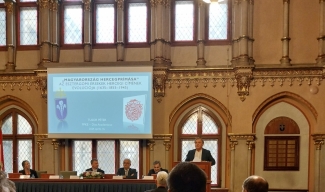
On April 16th, the Dies Academicus university day was held in the Pope St. John Paul II Hall at Pázmány Péter Catholic University, where newly appointed associate professors and professors of the Catholic University introduced themselves with their lectures.
As part of this event, Péter Tusor discussed the origin of the princely title of the Archbishops of Esztergom. In his presentation, he significantly reinterpreted the traditional standpoint represented, among others, by Antal Meszlényi. Based on source criticism, he demonstrated that the claim to the princely title already appears in the time of Péter Pázmány. Péter Pázmány's successors were consistently addressed as "Celsissime Princeps" in the missives. The Hungarian version of the address appears in the case of György Széchényi as "Méltóságos és Nagyságos Fejedelem" (Illustrious and Magnificent Prince). The granting of the princely title in 1714, at the request of Ágost Keresztély, can be interpreted in connection with these precedents. Subsequently, the Archbishops of Esztergom used the title of prince of the Holy Roman Empire (Princeps Sacri Romani Imperii [S.R.I.]) in their own intitulations. Keresztély Ágost himself also used it, who had previously been only Duke of Saxony.
Most of the time, the princely rank, associated with the person of the incumbent archbishop, was linked to the primatial title in the 19th century, particularly with János Scitovszky. From the Middle Ages, the Archbishops of Esztergom were the primates of the country, and following the claim formulated by Pázmány, they were also princes from 1714 onwards. The prestigious expression "Prince Primate of Hungary" was coined in 1855, after numerous informal appearances in the first half of the 19th century, coinciding with the conclusion of the Austrian Concordat. From then on, it became the official title of the Archbishops of Esztergom, and even preceded the archbishopric in informal usage. The concept of "Princeps-Primas inclyti Regni Hungariae" is based on real historical precedents but took its current form during the Romantic and Historicism era, in connection with the defense of Hungarian national and ecclesiastical independence. Its role in preserving historical and national identity became even more significant after the Treaty of Trianon, during the period of the kingdom without a king, and particularly after 1945.
A comprehensive study containing the results of this research ("The Princely Title of the Archbishops of Esztergom from Pázmány to Scitovszky, 1635–1855") will be published in the near future. The detailed exposition of the Pázmány claims was published in 2022. You can listen to the recording of the lecture below, and the PowerPoint presentation can be viewed here.
